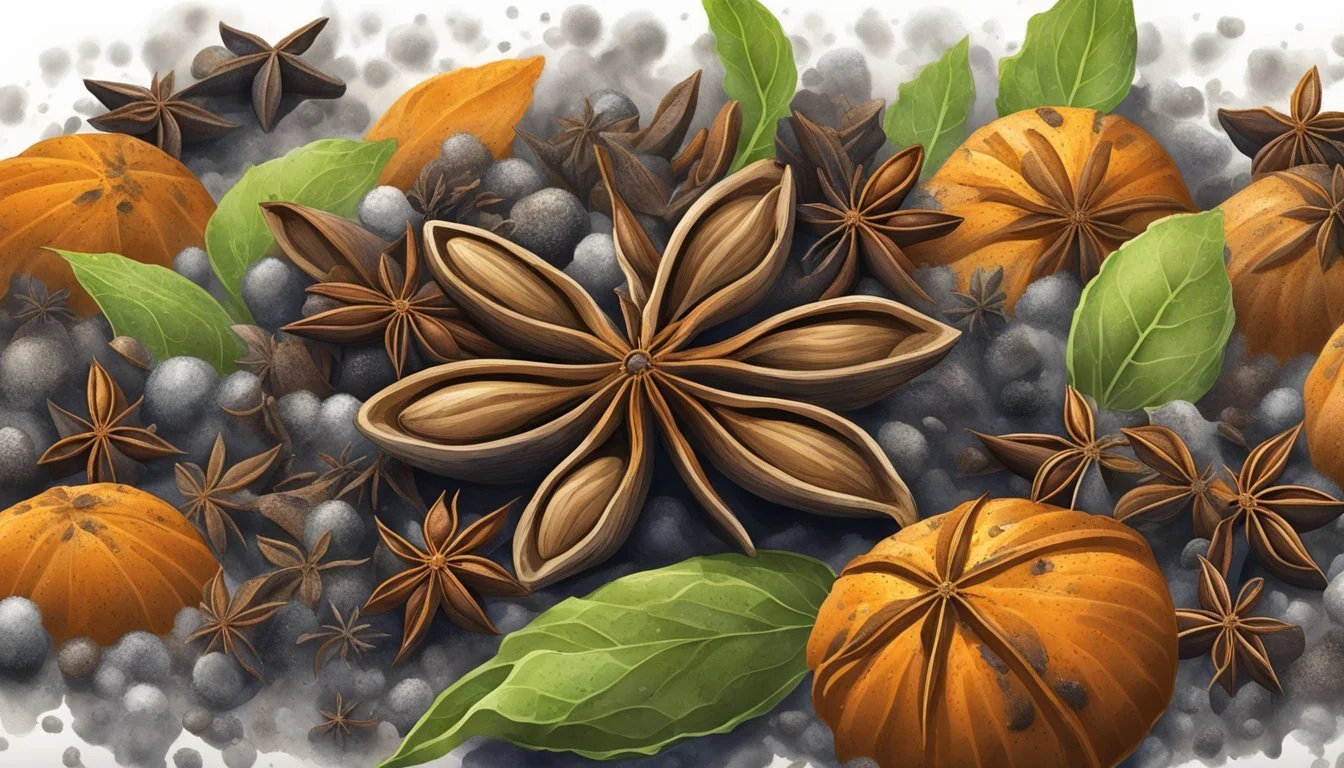Does Star Anise Go Bad? How to Tell and Store It
Star anise, with its unique star-shaped appearance and licorice-like flavor, is a common spice in many kitchens. Like other spices, it can lose its quality over time. Star anise can go bad if exposed to moisture, pests, or improper storage, leading to a loss of its potent aroma and taste.
Proper storage is key to maintaining the freshness of star anise. Keeping it in a cool, dry place, away from light and stored in a sealed container, can help prolong its shelf life. Even under optimal conditions, cooks should be aware that whole star anise generally retains its best qualities for about a year.
For culinary enthusiasts, knowing the signs of when star anise has diminished in quality is crucial. Look for a strong smell and intact star shapes to ensure you’re using a spice that will impart the best flavor to your dishes.
Understanding Star Anise
Star anise, derived from the fruit of the Illicium verum plant, is an evergreen tree native to regions like China and Vietnam. This spice is notable for its star-shaped pods and possesses a flavor reminiscent of licorice, making it a versatile and unique ingredient in various culinary applications.
Origins and Cultural Significance
Star anise originates from China and Vietnam where it has long-standing cultural and culinary significance. The Illicium verum plant thrives as an evergreen tree in these regions, producing the distinctive star-shaped spice. Historically, it has been a staple in traditional Chinese medicine and cuisine.
In China, star anise is a key component of the famous five-spice powder. It plays an essential role in flavoring meats and soups. In Vietnam, it is crucial for the unique taste of dishes like pho, a traditional noodle soup. The cultural affinity for star anise stretches beyond culinary uses, embracing medicinal practices as well.
Star Anise in Culinary Uses
In cooking, star anise is used either whole or ground. It is particularly valued for its strong licorice-like flavor, which can complement both sweet and savory dishes. In Chinese cuisine, it is a staple in recipes such as braised meat dishes and soups.
Star anise’s versatility extends to Vietnamese recipes, especially in rich, aromatic broths for soups like pho. Beyond Southeast Asian use, this spice flavors various soups, stews, and sauces worldwide. Additionally, star anise is used in desserts, sometimes being incorporated into spiced syrups or baked goods.
Comparing Star Anise to Other Spices
Star anise is often compared to anise seed, fennel, and licorice due to its similar flavor profile. While all these spices share a licorice-like flavor, star anise tends to be stronger and more aromatic.
Anise seed, smaller and less potent, is more commonly used in liquors and confectionery. Fennel has a milder, sweeter taste, making it suitable for both culinary and medicinal uses. Star anise’s robust flavor makes it a standout in dishes that require a deep, warming spice note.
In summary, star anise's bold flavor and culinary versatility distinguish it from similar spices, making it an invaluable addition to diverse cuisines.
Shelf Life and Proper Storage
Whole star anise can remain fresh for about a year, while ground star anise typically lasts around six months. Proper storage conditions can help extend their potency and ensure optimal flavor and aroma.
Identifying Fresh vs Aged Star Anise
Fresh star anise is known for its strong, pungent aroma and intact star shapes. The color should be a rich brown with a slightly glossy sheen. Aging star anise often appears duller and may have a weaker smell. Look for unbroken stars, as broken pieces can indicate brittleness due to aging. When ground, the spice should maintain a consistent color and fragrant aroma.
Optimal Storage Conditions
To maximize the shelf life of star anise, it is crucial to store it properly. Whole star anise should be kept in an airtight container in a cool, dry place such as a pantry. Avoid exposure to moisture, heat, and direct sunlight. Glass jars with tight seals are ideal for maintaining freshness. Ground star anise should be stored similarly but used more quickly due to its shorter shelf life. Regularly rotating the stock and using the oldest spice first ensures optimal usage.
Impact on Health and Nutrition
Star anise offers various nutritional benefits, though it also carries potential risks. It contains powerful compounds that contribute to its health-promoting qualities but may pose side effects if not consumed appropriately.
Nutritional Benefits
Star anise is known for its antiviral and antibacterial properties, making it beneficial in boosting the immune system. Shikimic acid, a compound found in star anise, is a key ingredient in antiviral medications.
This spice also possesses antioxidant properties, which help combat oxidative stress and inflammation. Consuming star anise can support heart health and potentially reduce the risk of certain cancers. It is often used in teas and beverages to harness these benefits.
Star anise also contains essential oils, such as anethole, which contribute to its licorice-like flavor and aroma. These oils have shown effectiveness in regulating blood sugar levels and aiding digestion. In cuisine, star anise enhances the nutritional profile of various dishes.
Understanding Potential Risks
Despite its benefits, there are notable risks associated with star anise. Japanese star anise is toxic and should not be consumed, as it contains harmful compounds that can lead to severe side effects. Even small amounts can be dangerous.
High doses of star anise or its essential oil can cause adverse reactions like nausea, vomiting, and convulsions. The FDA has issued warnings about teas containing star anise due to risks such as rapid eye movements and increased muscle tone. It's crucial to stay within recommended dosages to avoid these health hazards.
Consumers should be cautious and seek medical advice before including star anise in their diet, especially in large quantities or in concentrated forms such as essential oils. Proper identification and moderation are key to safely enjoying the health benefits of this potent spice.
Culinary Applications and Techniques
Star anise is a versatile spice that enriches dishes with its spicy warmth and unique licorice-like flavor. It shines in both sweet and savory recipes, where its aromatic properties can elevate the overall taste experience.
Incorporating Star Anise in Recipes
In cooking, star anise is particularly popular in Asian dishes like pho and braised meats. It pairs well with other herbs and spices such as cinnamon, cloves, and fennel seeds.
Use whole pods in stews, broths, and sauces to infuse a complex flavor profile. Remember to remove the pods before serving as they can be tough to chew. When ground, star anise can be added directly to spice rubs and marinades for meats, fish, or tofu. Ground star anise can also enhance the flavor of baked goods and desserts.
Creating Flavorful Infusions
Infusing star anise in liquids maximizes its flavor and aroma. Toast whole pods lightly in a dry pan to release their essential oils before adding them to teas, liquors, or cooking broths.
For a simple infusion, add one or two whole pods to your boiling water or milk, and let it steep. This technique is also effective in making spiced syrups for cocktails. Always monitor the infusion process closely to avoid over-extracting, which can result in a bitter taste.
Substitutes and Alternatives
In cases where star anise is unavailable, several substitutes can replicate its flavor notes. Chinese five-spice powder, which often contains star anise, can serve as a ready replacement.
For a more tailored substitute, consider a mix of cinnamon and cloves with a pinch of fennel seeds. These alternatives can mimic the spicy, sweet undertones of star anise. Always adjust measurements to taste, as these substitutes may differ in intensity.
By understanding these culinary applications and techniques, cooking with star anise becomes an enriching experience, adding depth and aromatic complexity to a variety of dishes.
Purchasing and Quality Assessment
When buying star anise, it is crucial to focus on the quality of the pods to ensure robust flavor and aroma. Equally important is recognizing signs of spoilage and contamination to avoid using subpar ingredients.
Finding High-Quality Star Anise
To select high-quality star anise, look for whole, unbroken pods with a rich, brown color. These pods should have a strong, sweet, and spicy aroma, indicative of fresh, potent spices. Star anise is a key ingredient in many spice blends, including Chinese five-spice powder, so obtaining the best quality will enhance these recipes.
When purchasing, check for visible signs of damage or contamination. Good quality star anise is typically sourced from regions like Vietnam, known for producing premium spices. Ensure packaging is intact and airtight to maintain freshness.
Buying from reputable sources, such as specialty spice shops or trusted grocery stores, can help guarantee the quality of the star anise.
Recognizing Spoilage and Contamination
Star anise can spoil or become contaminated if not stored properly. Mold and bacterial growth can occur if the spice is exposed to moisture. Look for any white or greenish spots on the pods, which are clear indicators of mold.
Contamination from pests like weevils or pantry moths is another concern. Check for tiny holes in the pods or the presence of insects.
Spoiled star anise often loses its characteristic strong smell, becoming faint or musty. Ensure that the pods are stored in an airtight container in a cool, dry place to prolong their shelf life and maintain their sweet and spicy aroma. Regular inspection of the stored spices can prevent the use of compromised ingredients.
Cultural and Global Influence
Star anise has been deeply woven into the cultural and culinary fabric of various regions worldwide. Its journey from ancient practices to modern global adaptation highlights its multifaceted significance.
Star Anise in Traditional Practices
In traditional Chinese medicine, star anise is prized for its medicinal uses. It is believed to aid digestion, relieve colic, and treat respiratory infections. The spice is a key component in herbal teas and other remedies.
Star anise also plays a vital role in religious ceremonies and festivals across Southeast Asia. It's used to symbolically ward off evil spirits. In Vietnam, it's the defining flavor of the renowned dish Vietnamese pho, infusing broths with its aromatic sweetness.
In the Middle East, star anise and its relative, aniseed, feature prominently in both culinary arts and traditional medicine. From fragrant bread to soothing teas, the spice's influence is deeply rooted in these cultures.
Global Adaptation and Uses
Star anise has transcended its regional origins and integrated into various global cuisines. It is a staple in Chinese five-spice powder, which is essential for flavoring meats and sauces. Beyond Asia, star anise adds depth to European desserts and mulled wines.
The Western pharmaceutical industry has also tapped into its potential. Shikimic acid, found in star anise, is a vital ingredient in the production of the anti-influenza drug Tamiflu. This utilization underscores its importance beyond the kitchen.
Culinary professionals and home cooks alike have embraced star anise for its unique flavor and versatility. Its applications range from savory to sweet, making it a cherished ingredient in diverse international dishes.







